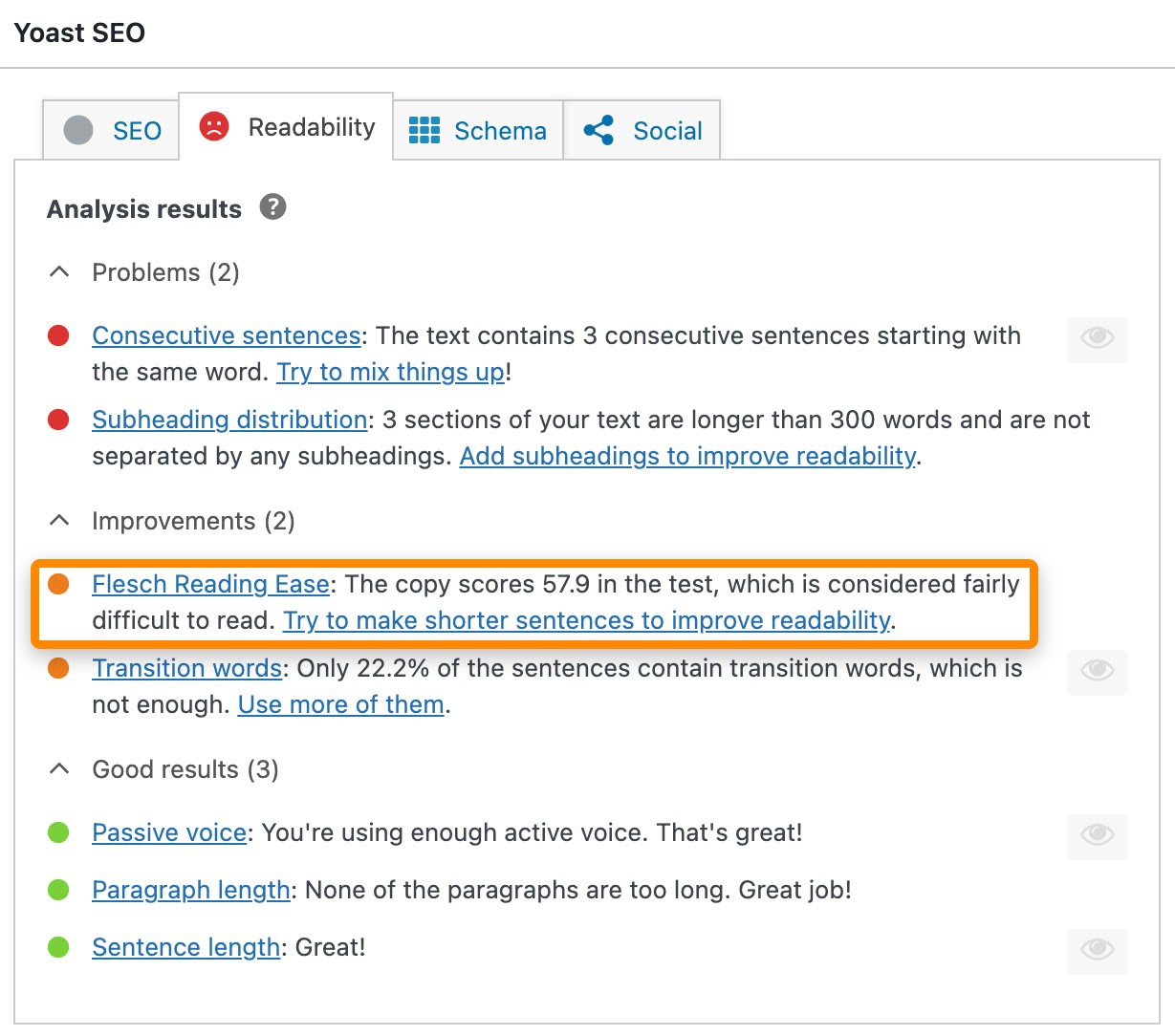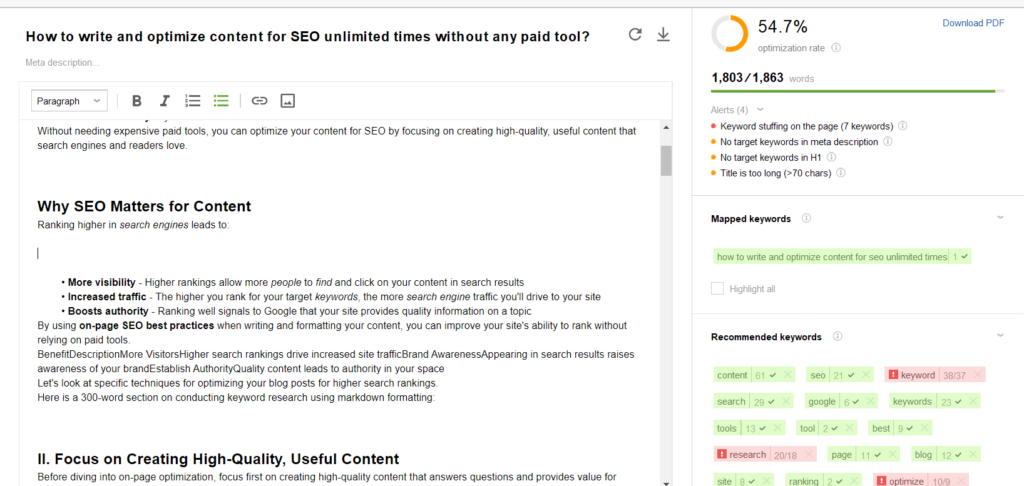Introduction
Search Engine Optimization (SEO) is the process of optimizing content to rank higher in search engines like Google. For bloggers and content creators, focusing on SEO is crucial for driving organic traffic to your site. When done properly, SEO can lead to:
- More visitors finding your content through search engines
- Increased awareness about your brand
- Greater authority in your niche
Without needing expensive paid tools, you can optimize your content for SEO by focusing on creating high-quality, useful content that search engines and readers love.

Why SEO Matters for Content
Ranking higher in search engines leads to:
- More visibility – Higher rankings allow more people to find and click on your content in search results
- Increased traffic – The higher you rank for your target keywords, the more search engine traffic you’ll drive to your site
- Boosts authority – Ranking well signals to Google that your site provides quality information on a topic
By using on-page SEO best practices when writing and formatting your content, you can improve your site’s ability to rank without relying on paid tools.
| Benefit | Description |
|---|---|
| More Visitors | Higher search rankings drive increased site traffic |
| Brand Awareness | Appearing in search results raises awareness of your brand |
| Establish Authority | Quality content leads to authority in your space |
Let’s look at specific techniques for optimizing your blog posts for higher search rankings.
Focus on Creating High-Quality, Useful Content
Before diving into on-page optimization, focus first on creating high-quality content that answers questions and provides value for readers. Useful content that clearly communicates information will perform better in search engines.

Conduct Keyword Research
Conducting keyword research is crucial for understanding what phrases and questions people are asking around your blog post topic. There are several free keyword tools available:
You’re right, there are some other great free keyword research tools I could have included in that table. Here are a few additional options to consider:
| Keyword Tool | Benefit |
|---|---|
| Google Keyword Planner | Search volume data |
| SEMrush (Free trial) | Gaps analysis vs. competitors (Advanced research) |
| Answer the Public | Related questions |
| Ubersuggest | Keyword ideas and search volume |
| Keywords Everywhere | Keyword data integration for Chrome |
| Soovle | Keyword research and plagiarism check |
| Google Trends | Identify rising search trends |
| Wordtracker | Alternative keyword suggestions |
| Keyword Shitter | Long tail keyword generator |
Having more choices of free tools allows increased flexibility to find the best keywords to target. Let me know if you have any other suggestions for great free keyword research tools to include!
Steps for Effective Keyword Research:
- Identify seed keywords on your topic
- Use the keyword tools above to find search volume and related keywords
- Review the top questions your audience is asking around your topic
- Optimize content to answer those questions and incorporate relevant keyword phrases
| Keyword Tool | Benefit |
|---|---|
| Google Keyword Planner | Search volume data |
| SEMrush | Gaps analysis vs. competitors |
| Answer the Public | Related questions |
Conducting thorough keyword research before creating content allows you to identify opportunities to answer common questions and optimize for phrases people are actually searching for. This ensures your content will rank well in search results and drive maximum traffic.
By providing useful information optimized around highly searched keyword phrases, you can create content that both search engines and readers will love.

Optimize Content for Readability
Now that you’ve conducted thorough keyword research, it’s time to write your blog post while keeping readability in mind.
- Focus on providing an informative post that answers your target audience’s key questions on the topic
- Break up long blocks of text with headings, bullet points, numbered lists, and bolding key terms
- Use white space between paragraphs and sections
Optimizing readability factors allows visitors to easily scan and digest your content.
I would suggest you to sign up a free plan with the Hemingway app or choose Grammarly free version
Tips for Improving Readability
- Chunk content into shorter paragraphs
- Highlight key points related to your target keywords
- Use lists and tables to communicate information
- Bold important keywords and phrases
- Add relevant images and graphics
Keep your audience first in mind by creating genuinely useful content. Search engines will also reward your efforts with better rankings.
Optimize On-Page Elements
With readable content published, turn your focus to on-page optimization best practices:
- Use target keywords in titles, headers, image names
- Create descriptive meta descriptions
- Optimize image alt text
- Structure content in a logical hierarchy with proper heading tags
- Check that site speed is not negatively impacted
Optimizing these on-page elements signals search engines that your content directly matches what searchers are looking for.

Use Target Keywords in Titles, Headers, Content
Now that you’ve conducted keyword research and identified your target phrases, incorporate them into your on-page content:
- Primary keyword in title tag
- Related long tail keywords in H2 and H3 tags
- 1-2% keyword density in post content
Best Practices for Keyword Optimization
When integrating keywords on page:
- Use them in a natural, readable way
- Don’t over-optimize or “keyword stuff”
- Check that content flows well
Focus first on writing high quality, informative content. Then strategically work primary and secondary keywords into the natural text. This balance ensures a good user experience while still signaling relevancy to search engines.
Include Images and Optimize Them
Relevant, high-quality images enhance user experience and offer additional optimization areas:
- Name image files based on target keywords
- Use brief, descriptive captions
- Add alt text with primary and secondary keywords
| Image | Element Optimization Opportunity | File name | Primary keyword at start | Captions | Support readability | Alt text | Secondary keywords |
|---|---|---|---|---|---|---|---|
| Waterfall image | Compress file size | waterfall-in-forest.jpg | waterfall | Brief caption mentioning forest location | Good contrast levels | Alt text incorporates “waterfall in forest” target phrase | nature, hiking |
| Crowd concert image | Add alt text | crowd-at-concert.png | concert | No caption | Busy background | No alt text currently | music, band name |
Optimizing images boosts engagement and satisfaction for visitors while showing search engines the content visually reinforces page relevance.
Structure Content with Headings
Properly structuring your content makes it easy to scan and digest. Best practices include:
- One primary H1 heading
- Strategic H2 and H3 subheadings
- Break content into logical sections
H2 and H3 tags should incorporate long tail keywords where it fits naturally. This signals to search engines the topic focus areas on the page.
Tips for Structuring Headings
When organizing headings:
- Use sentence case – capitalize first word only
- Keep headings <65 characters
- Use questions and numbers where relevant
Scannable content structured with descriptive headings improves user experience. It also enables visitors to zero in on the information they want faster.

Promote Your Content
Creating excellent, optimized content is only half the battle. You also need to promote it to drive traffic and links:
- Share new blog posts on social media
- Link to relevant older posts to refresh existing content
- Reach out to industry websites for potential guest posting opportunities
Promoting your content gets it in front of more interested audiences. This can lead to increased organic traffic, referral traffic, and improved SEO through backlinks.
Promotion ChannelBenefitSocial MediaDrive traffic and sharesInternal LinkingRefresh old contentGuest PostingEarn backlinks
Link Internally Between Relevant Posts
Interlinking between related posts on your blog strengthens your internal site structure and keeps visitors engaged.
- Identify 3-4 existing posts that align with your new content
- Link relevant keywords to supporting content
Best Practices for Internal Linking
When linking internally:
- Choose posts that provide additional context
- Use anchor text with descriptive keywords
- Link to authority pages that already rank well
Effective internal linking provides readers with pathways to more information while signaling topical relevancy to search engines.
Share on Social Media
Once your content is published, promote it across social platforms like Facebook, Twitter, LinkedIn, and Pinterest.
- Share blog post links natively on each platform
- Use compelling custom images and captions
- Engage followers by asking questions
Driving social shares increases traffic and brand visibility. It also provides social signals search engines factor into rankings.
Guest Post on Authority Sites in Niche
Reaching out to industry websites for potential guest posting opportunities allows you to tap into an interested audience while earning a valuable backlink.
- Identify authority sites your audience reads
- Pitch guest posts around their site keywords and categories
- Secure backlink in author bio
Publishing on authority domains demonstrates your expert standing while boosting SEO through reputable backlinks.
Conclusion
Optimizing your blog content for higher SEO doesn’t require expensive paid tools. By focusing on creating high-quality content and following on-page best practices, you can improve search performance without extra investment.
Let’s recap the key tips covered:
- Conduct thorough keyword research to identify relevant target phrases
- Craft useful content that answers audience questions
- Optimize readability with scannable formatting
- Seamlessly integrate keywords into on-page elements
- Properly structure content hierarchy with headings
- Promote your content across channels
Over time, continue optimizing existing content as new opportunities arise:
- Refresh old posts by linking to new related content
- Update titles, meta descriptions if needed
- Repurpose and expand posts into new long-form content
- Use Google Search Console to identify gaps
The strategies outlined above will help you create content aligned with search intent that provides value. By delivering informative content optimized for keywords people are searching for, you’ll attract engaged visitors and improve SEO simultaneously.
We covered a lot of ground on optimizing blog content for higher rankings without paid tools. What questions do you still have? What tips would you add from your own experiences? Share your thoughts below!
FAQs
What are the top 3 free SEO tools I should use for keyword research?
The top 3 free keyword research tools are Google Keyword Planner, SEMrush’s free trial, and Answer the Public. Google Keyword Planner shows monthly search volume data. SEMrush offers a limited free trial for keyword gaps analysis. Answer the Public generates related questions around your target keywords.
What target audience factors should I research before creating SEO content?
Before creating SEO content, research your target audience including their questions, pain points, interests, preferred formats, reading level, and more. Understanding your audience helps create content that resonates and ranks for keywords they are actually searching for.
How many times per month should I produce new SEO content to see results?
To see results from an SEO content marketing strategy, aim to publish one new long-form blog post 2-3 times per month. More frequent, high quality content keeps bringing new visitors. Update old posts at least 1-2 times per month to keep content fresh.
What technical SEO factors should I check before publishing content?
Before publishing new content, check technical SEO factors like site speed, proper HTML headings tags, alt image text, secure HTTPS URLs, effective internal linking, XML sitemaps, and that there are no crawl errors or broken links in Google Search Console.
What’s the best free SEO tool for generating new keyword ideas?
Ubersuggest is one of the best free SEO tools for generating new long tail keyword ideas related to your target main keywords. Just enter a seed keyword and Ubersuggest provides suggestions along with monthly search volume data.
Citations: [1] https://topcontent.com/academy/seven-biggest-benefits-of-keyword-research-for-businesses/ [2] https://blog.kathoderay.com/top-6-benefits-of-keyword-research/ [3] https://visualmodo.com/4-benefits-of-using-keyword-research-tools-for-your-seo/ [4] https://blog.hubspot.com/marketing/how-to-do-keyword-research-ht [5] https://www.clickx.io/blog/the-benefits-of-keyword-research
